Hillside Garden of Rooms
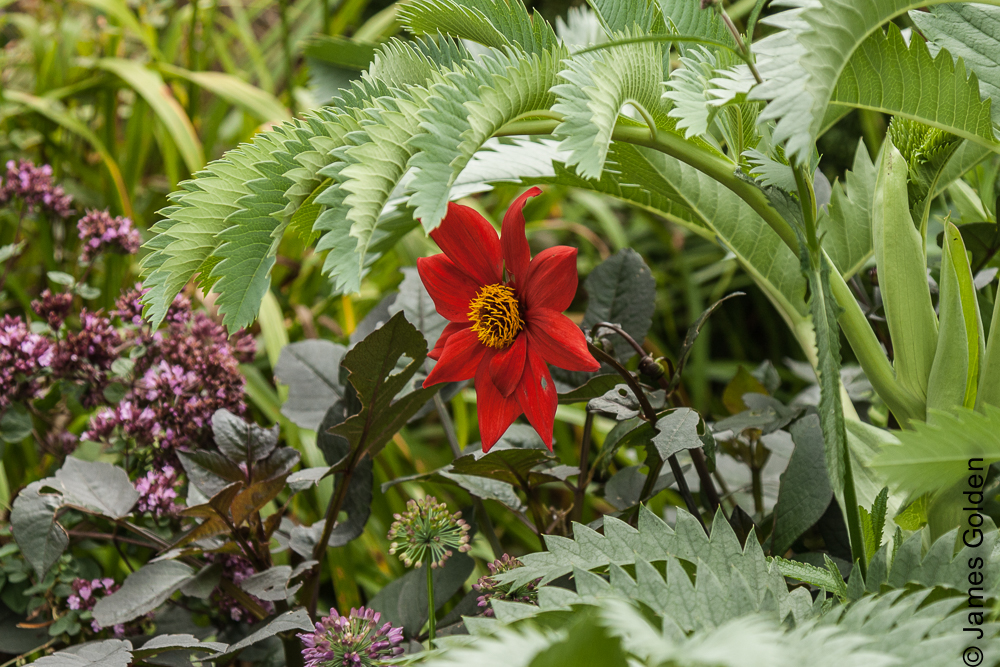 It was proof, yet again, that looking at photographs is an entirely different experience from actually seeing a garden. Michael Gordon's garden in Peterborough, New Hampshire, is one I've admired for years in photographs but experienced for the first time only last August at the Garden Conservancy Open Days. The astonishing composition of textures, shapes, and colors above is a beauty I'd have been unable to appreciate if I hadn't been there.The layout is hard to grasp in photos. The garden is on a steep hillside, and so is terraced, with four principal garden rooms, two level and two sloped. To me, this intricate arrangement of terraces and slopes recalls the spiral shape of a Nautilus shell (at least that's an apt metaphor) and is an elegant solution to gardening in limited space on a sloped site.Below is the first terrace, a curved lawn with impeccably planted borders and repeated box balls for rhythm and structural reinforcement. Box, perfectly trimmed, is a major unifying element in this garden.
It was proof, yet again, that looking at photographs is an entirely different experience from actually seeing a garden. Michael Gordon's garden in Peterborough, New Hampshire, is one I've admired for years in photographs but experienced for the first time only last August at the Garden Conservancy Open Days. The astonishing composition of textures, shapes, and colors above is a beauty I'd have been unable to appreciate if I hadn't been there.The layout is hard to grasp in photos. The garden is on a steep hillside, and so is terraced, with four principal garden rooms, two level and two sloped. To me, this intricate arrangement of terraces and slopes recalls the spiral shape of a Nautilus shell (at least that's an apt metaphor) and is an elegant solution to gardening in limited space on a sloped site.Below is the first terrace, a curved lawn with impeccably planted borders and repeated box balls for rhythm and structural reinforcement. Box, perfectly trimmed, is a major unifying element in this garden.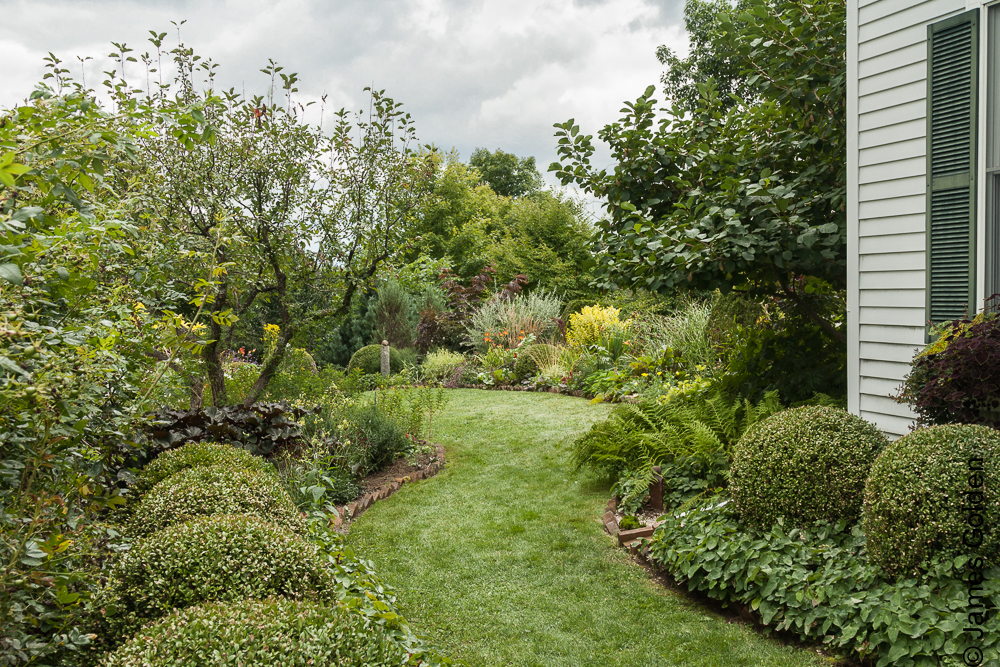 The lawn leads to a sloped transition area--Michael calls it the Hall with Balls--and another garden entrance, planted with more box, Carex 'Blue Zinger', and other happy plant combinations. It slopes down to the second terrace below this one.
The lawn leads to a sloped transition area--Michael calls it the Hall with Balls--and another garden entrance, planted with more box, Carex 'Blue Zinger', and other happy plant combinations. It slopes down to the second terrace below this one.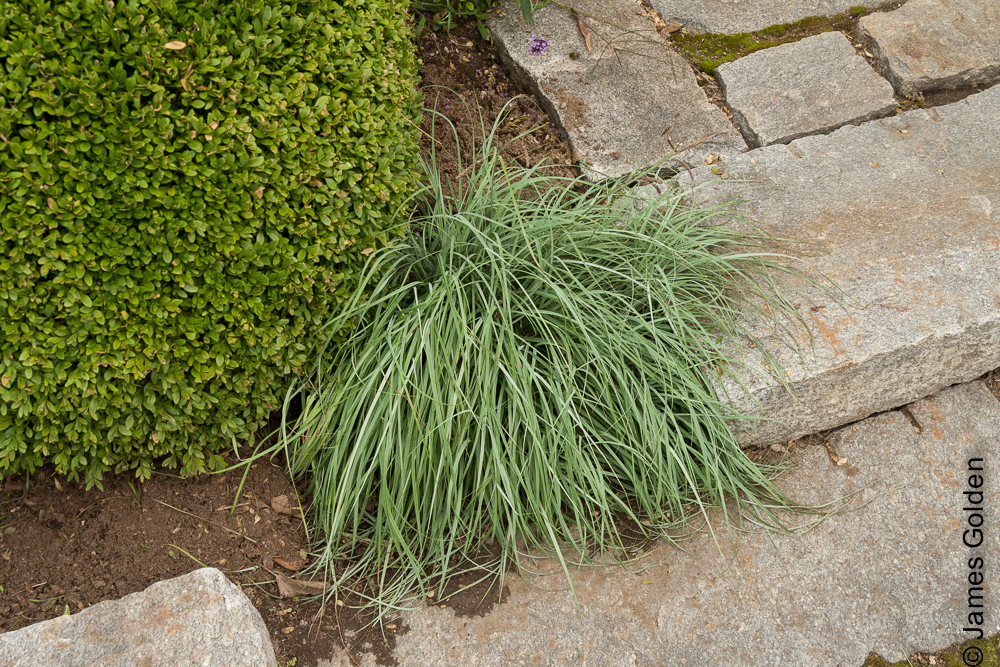 This aerial view from Google Maps shows the top terrace with curvilinear lawn parallel to the street, the Hall with Balls transition area at its end sloping down with a series of fine granite steps to the lower terrace, which has a long rectangular lawn and wide borders on three sides. At the bottom is a rather steeply sloped woodland garden with winding paths and steps. (This is an old photo that doesn't show the current state of the garden.)
This aerial view from Google Maps shows the top terrace with curvilinear lawn parallel to the street, the Hall with Balls transition area at its end sloping down with a series of fine granite steps to the lower terrace, which has a long rectangular lawn and wide borders on three sides. At the bottom is a rather steeply sloped woodland garden with winding paths and steps. (This is an old photo that doesn't show the current state of the garden.) If asked to classify this garden, I'd place it in the Arts and Crafts tradition of ornamented garden rooms, and it is a fine execution of that concept, with precise attention to detail. Look at the carefully composed plantings in the window boxes ...
If asked to classify this garden, I'd place it in the Arts and Crafts tradition of ornamented garden rooms, and it is a fine execution of that concept, with precise attention to detail. Look at the carefully composed plantings in the window boxes ...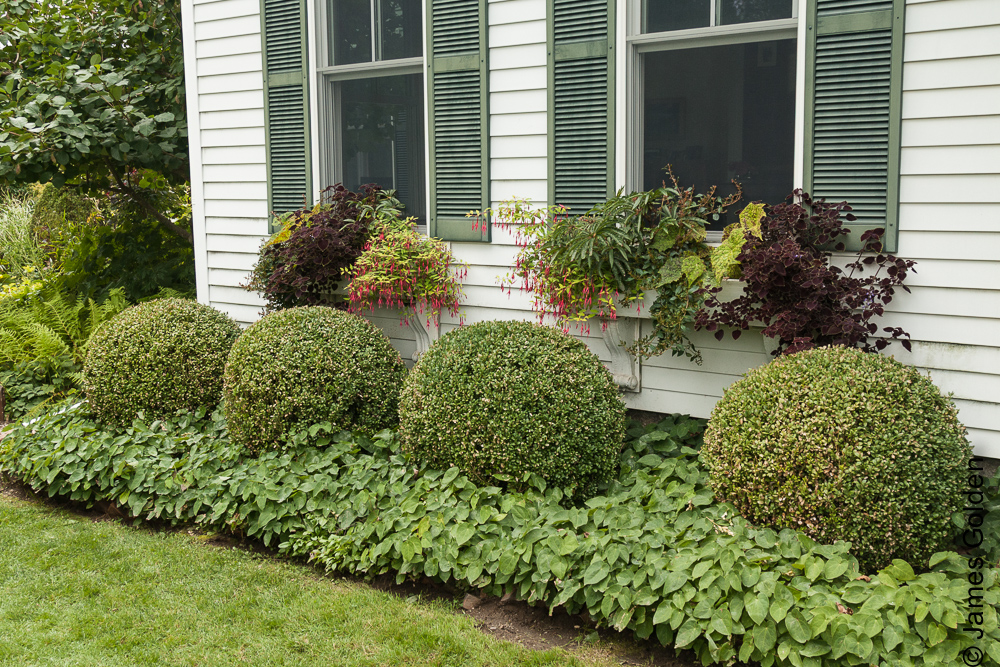 ... and the sea of epimedium "floating" the box balls on both sides of the lawn.
... and the sea of epimedium "floating" the box balls on both sides of the lawn. Near the end of the lawn and the Hall with Balls, as if preparing for the transition to the lower terrace, is this visual flourish of gold, bright orange, silver, and the purple of an annually stooled Gledistia 'Ruby Lace' (I think).
Near the end of the lawn and the Hall with Balls, as if preparing for the transition to the lower terrace, is this visual flourish of gold, bright orange, silver, and the purple of an annually stooled Gledistia 'Ruby Lace' (I think).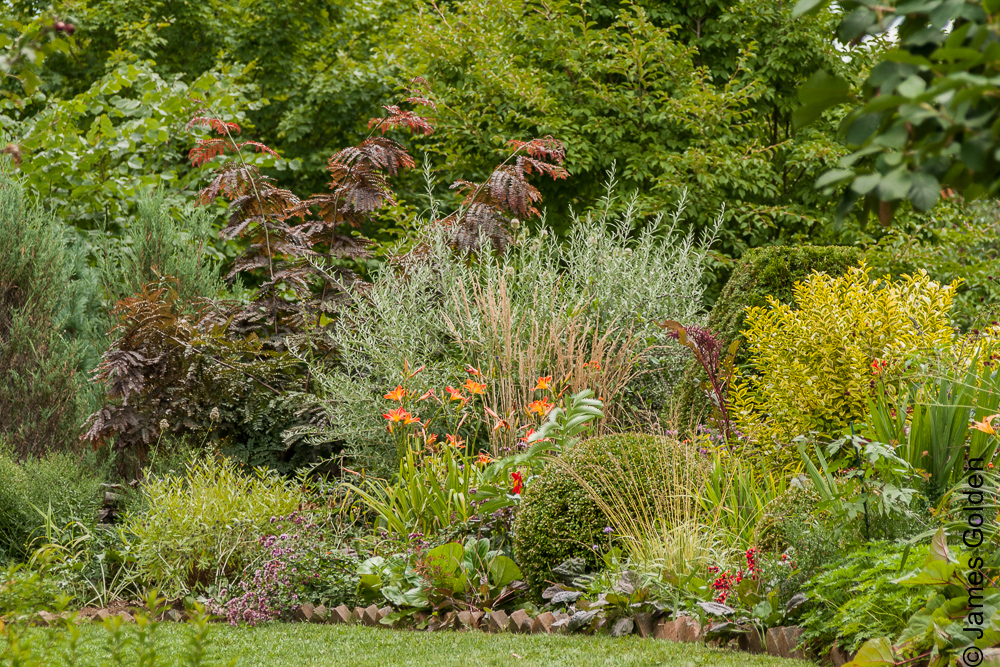 There's much more going on in this border. You can see, for example, the red dahlia and Melianthus major I chose as the opening photo of this post. In fact, there is a lot of of color and contrasting form and texture here, but it is all so tastefully blended you see the special vignettes only on close observation. This isn't a garden that shouts for attention, even though it uses bright colors and unusual forms when it wants to catch your interest. It has a quiet, thoughtful atmosphere.Here, careful observation of form and color makes for an imaginative juxtaposition of Symphytum 'Axminster Gold' with an almost miniature replication in Carex muskingumensis 'Oehme'. Both plants have linear foliage edged in gold, but this surprising pairing is one I would never have thought of. The orange day lily gives the combination an extra spark.
There's much more going on in this border. You can see, for example, the red dahlia and Melianthus major I chose as the opening photo of this post. In fact, there is a lot of of color and contrasting form and texture here, but it is all so tastefully blended you see the special vignettes only on close observation. This isn't a garden that shouts for attention, even though it uses bright colors and unusual forms when it wants to catch your interest. It has a quiet, thoughtful atmosphere.Here, careful observation of form and color makes for an imaginative juxtaposition of Symphytum 'Axminster Gold' with an almost miniature replication in Carex muskingumensis 'Oehme'. Both plants have linear foliage edged in gold, but this surprising pairing is one I would never have thought of. The orange day lily gives the combination an extra spark.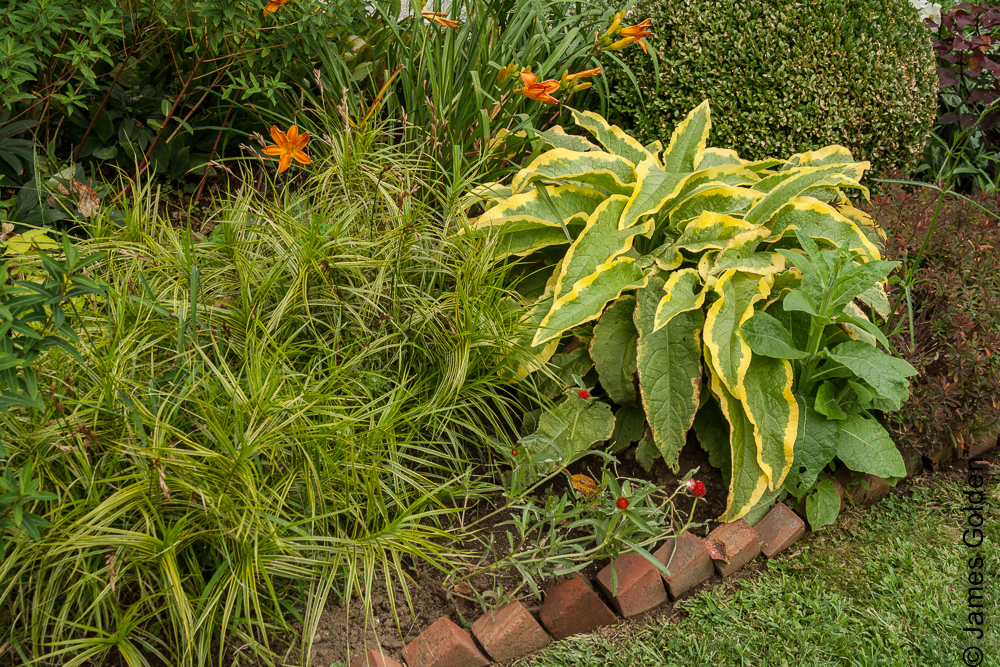 Here is the street entrance through the Hall with Balls, and the start of a stepwise descent to the lower terrace. Michael has placed a granite stele, framed in an arbor, on the opposite side of the lower terrace--reinforcing perception of the three-dimensional space, and pulling the eye toward the lower parts of the garden. The stele, in fact, marks the start of the third descent, into the woodland garden.
Here is the street entrance through the Hall with Balls, and the start of a stepwise descent to the lower terrace. Michael has placed a granite stele, framed in an arbor, on the opposite side of the lower terrace--reinforcing perception of the three-dimensional space, and pulling the eye toward the lower parts of the garden. The stele, in fact, marks the start of the third descent, into the woodland garden.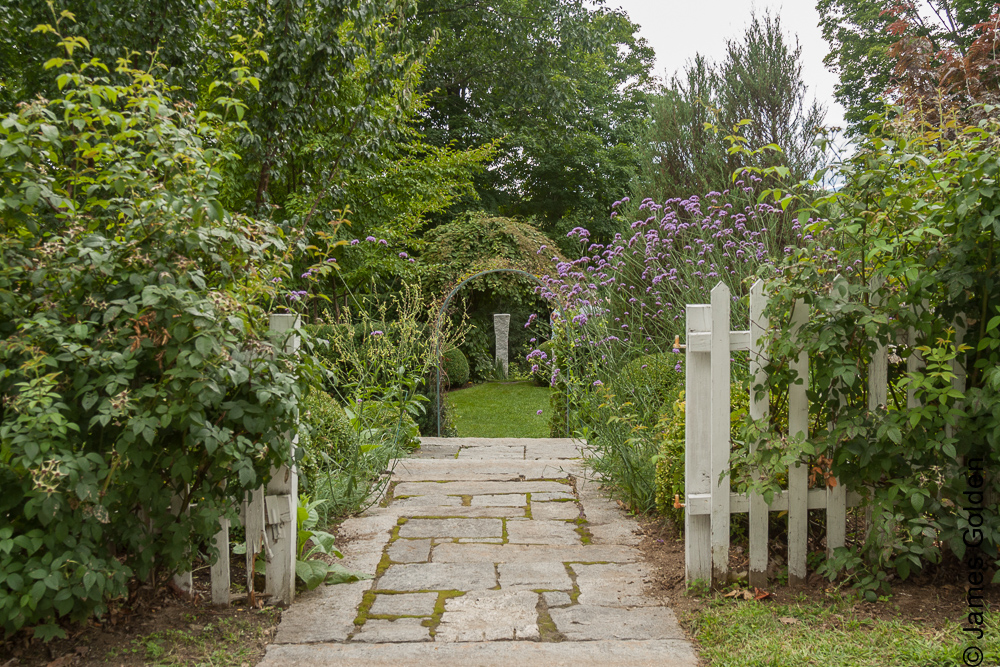 This is a beautifully composed scene that, in addition to serving as a practical guideway through the garden, makes a strong statement about the nature of the place--New Hampshire is "The Granite State"--and I think a powerful statement about archetypal transitions of life, among them, the "final" transition. The downward path, enticing though it is, the granite stele, an extremely powerful visual statement and one also reminiscent of a grave marker, recall various mythical descents to the underworld. This is quite a thought-provoking sequence. For me, this is the heart of the garden.
This is a beautifully composed scene that, in addition to serving as a practical guideway through the garden, makes a strong statement about the nature of the place--New Hampshire is "The Granite State"--and I think a powerful statement about archetypal transitions of life, among them, the "final" transition. The downward path, enticing though it is, the granite stele, an extremely powerful visual statement and one also reminiscent of a grave marker, recall various mythical descents to the underworld. This is quite a thought-provoking sequence. For me, this is the heart of the garden. This stone plinth bench marks the outer end of the second terrace. Its slightly asymmetrical symmetry has a classical feel and, for me, is strongly reminiscent of the nineteenth century in its more transcendental aspect. For some reason, perhaps because of its relaxed symmetry, it makes me think of Aspet, Saint-Gaudens studio and summer home in Cornish, New Hampshire. I think this connection I feel may be more an emotional response than a visual one--which brings us to the point that this is quite an emotional garden, subdued though it appears on first glance.
This stone plinth bench marks the outer end of the second terrace. Its slightly asymmetrical symmetry has a classical feel and, for me, is strongly reminiscent of the nineteenth century in its more transcendental aspect. For some reason, perhaps because of its relaxed symmetry, it makes me think of Aspet, Saint-Gaudens studio and summer home in Cornish, New Hampshire. I think this connection I feel may be more an emotional response than a visual one--which brings us to the point that this is quite an emotional garden, subdued though it appears on first glance.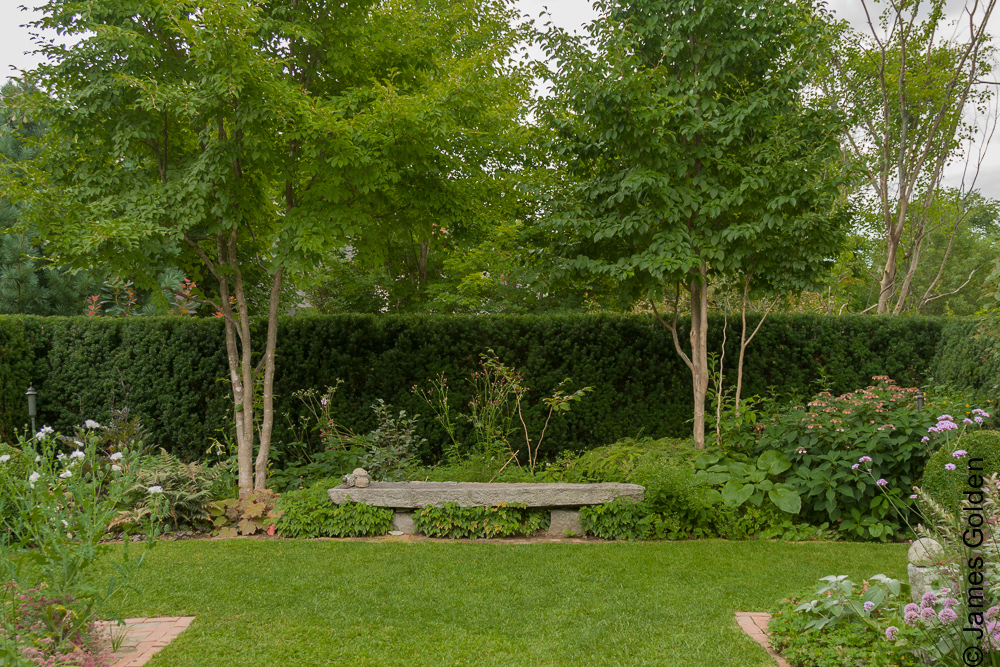 Looking away from the stone bench, the second terrace opens to the house and a pleasant sitting out area with four fine blue chairs.
Looking away from the stone bench, the second terrace opens to the house and a pleasant sitting out area with four fine blue chairs.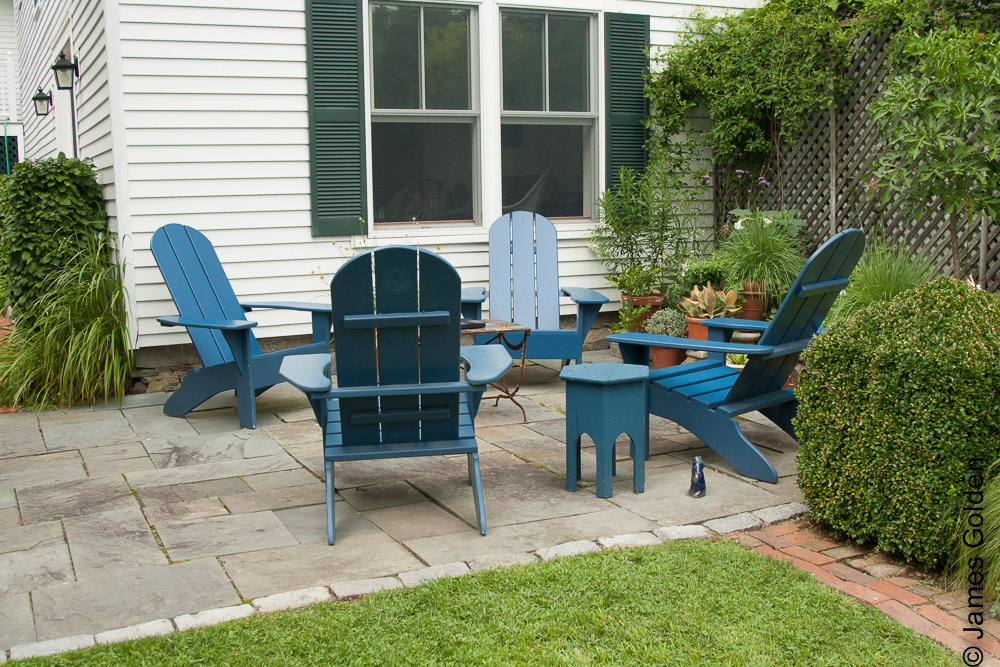 And then, a look back reveals more of the terrace ...
And then, a look back reveals more of the terrace ... ... and its parallel borders.
... and its parallel borders.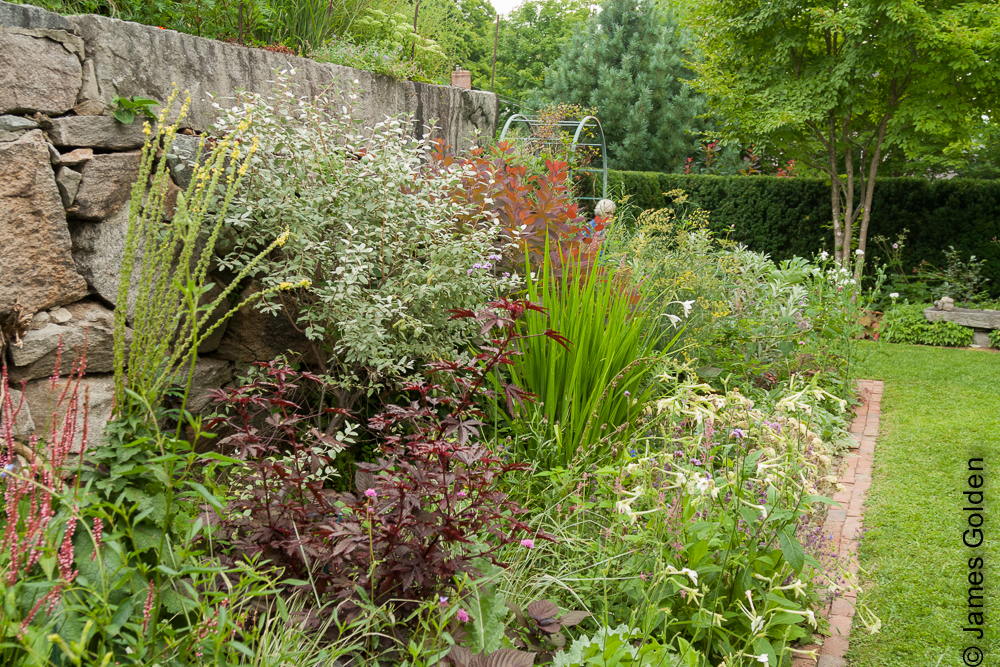
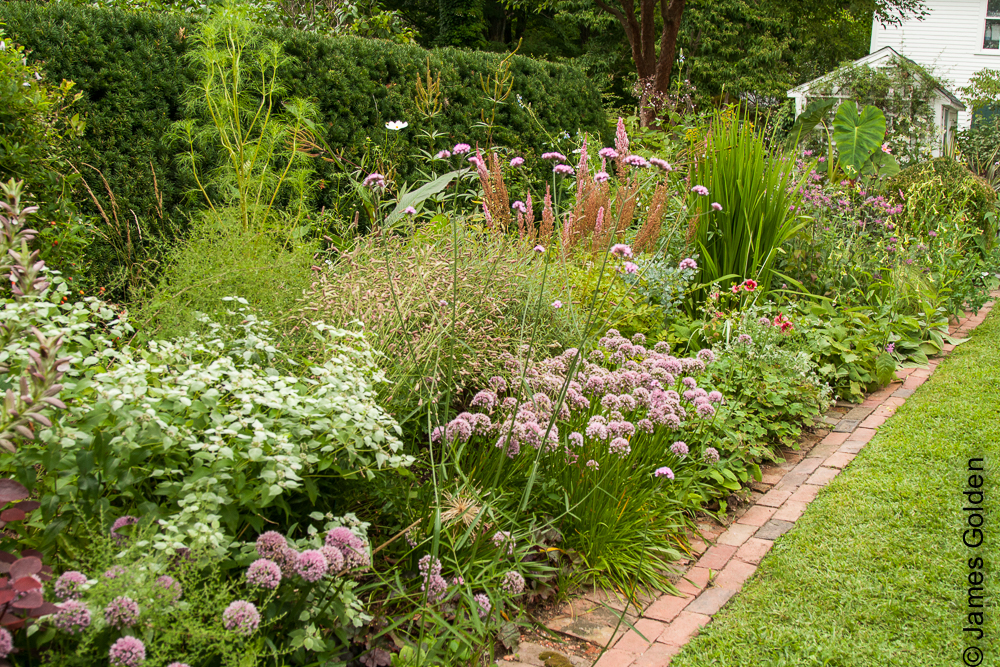 This is a particularly magical pairing, again unexpected, of Pycnanthemum muticum and a pale pink Sanguisorba.
This is a particularly magical pairing, again unexpected, of Pycnanthemum muticum and a pale pink Sanguisorba.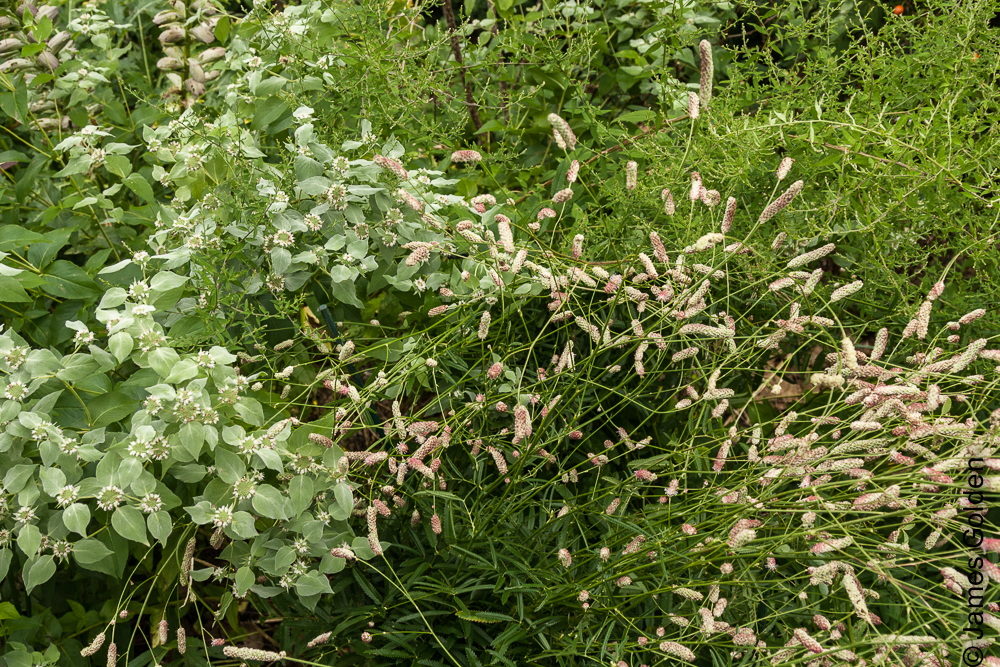 Returning to the opposite end and continuing through the arbor, you enter ...
Returning to the opposite end and continuing through the arbor, you enter ...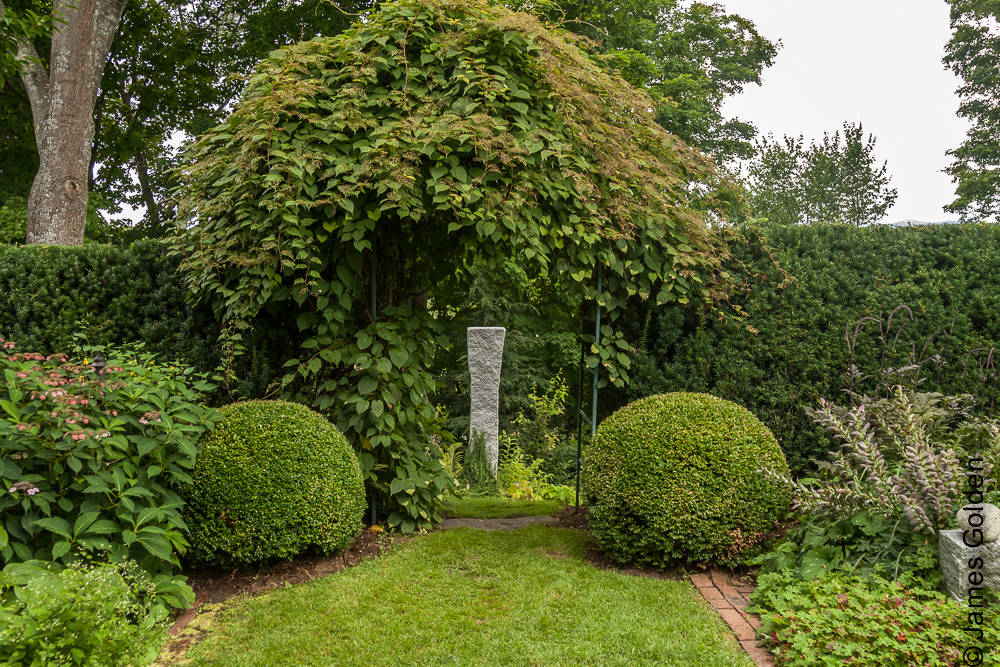 ... the woodland garden. Michael chose a dramatic contrast to the existing background trees, planting a Cercidiphyllum as the focal point of the lowest garden. The contrast in foliage, texture, and color is strong enough to define the space, even without other plantings.
... the woodland garden. Michael chose a dramatic contrast to the existing background trees, planting a Cercidiphyllum as the focal point of the lowest garden. The contrast in foliage, texture, and color is strong enough to define the space, even without other plantings.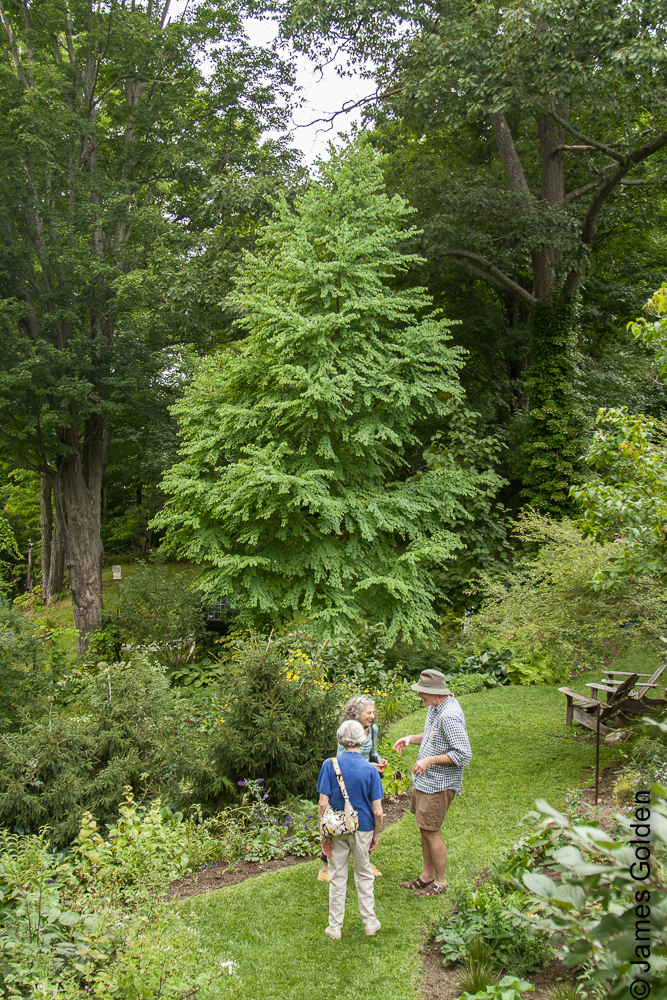 But there are many other plantings (shown below) ... and this part of the garden is still a work in progress.
But there are many other plantings (shown below) ... and this part of the garden is still a work in progress.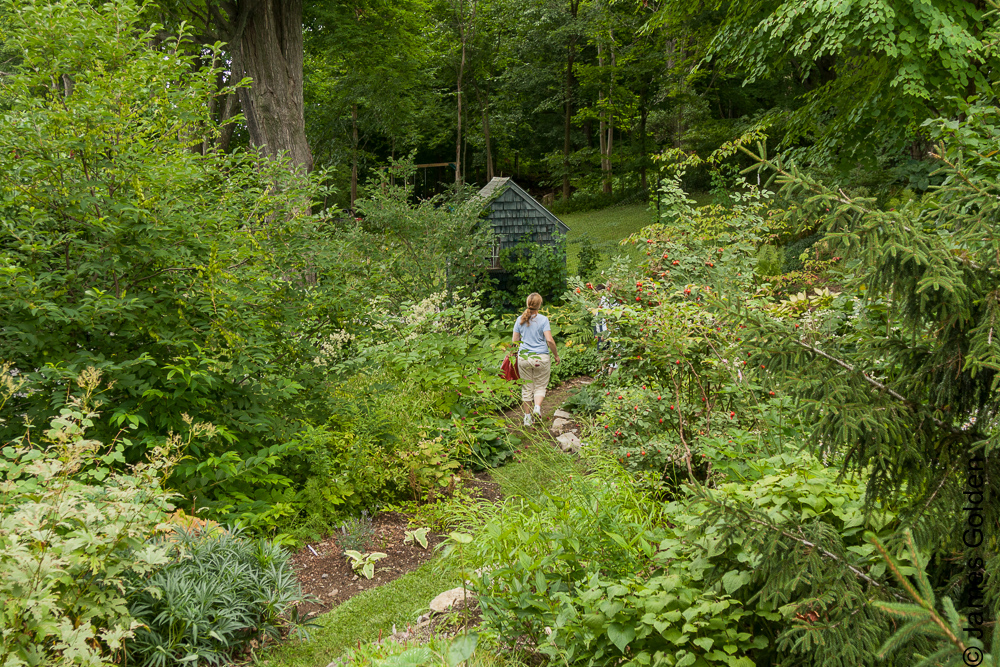
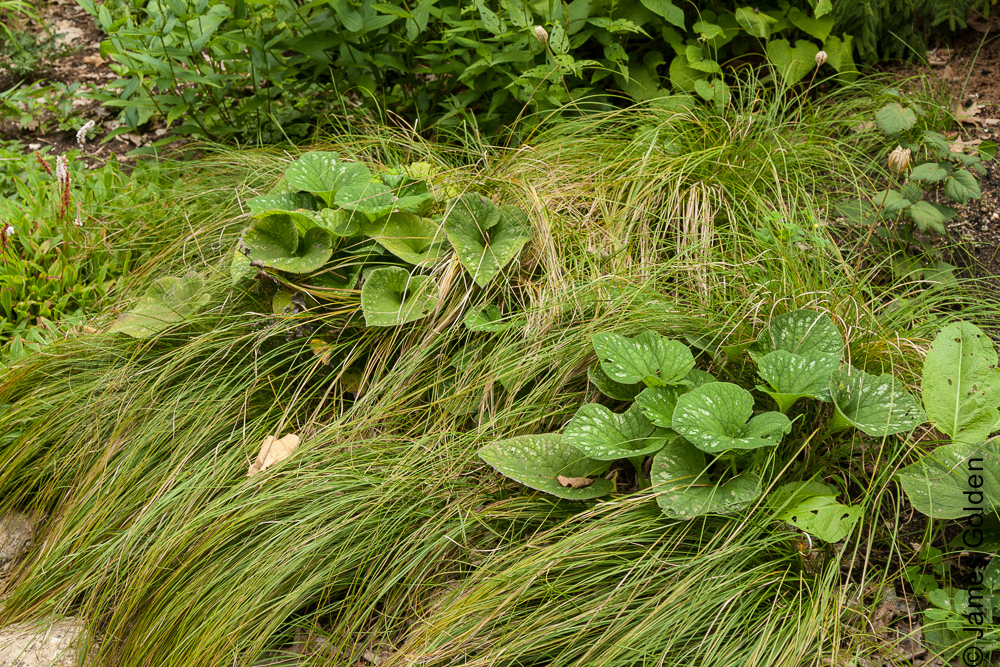
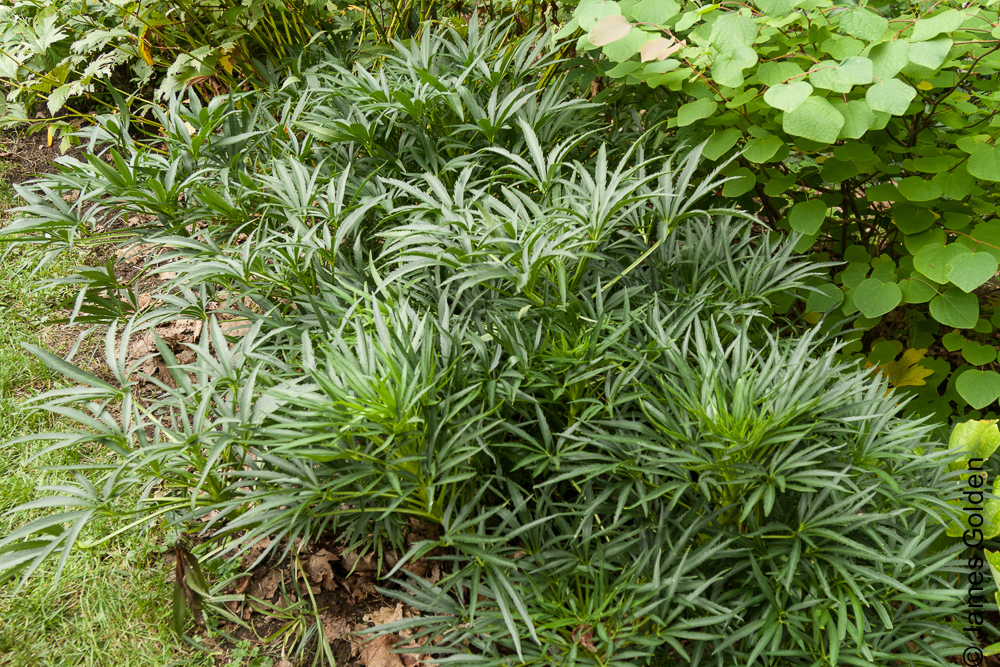
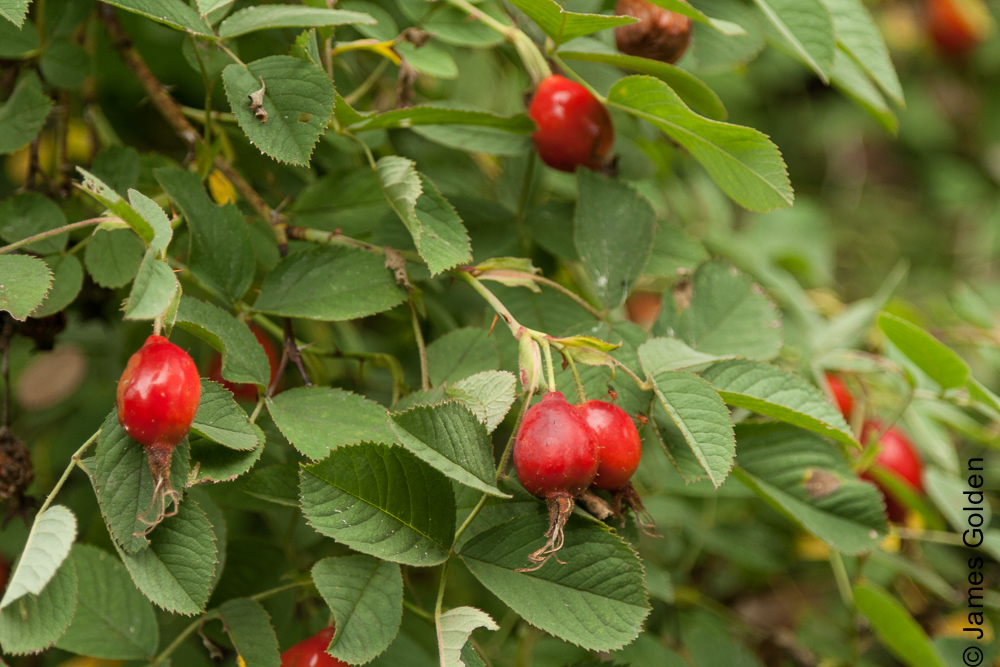
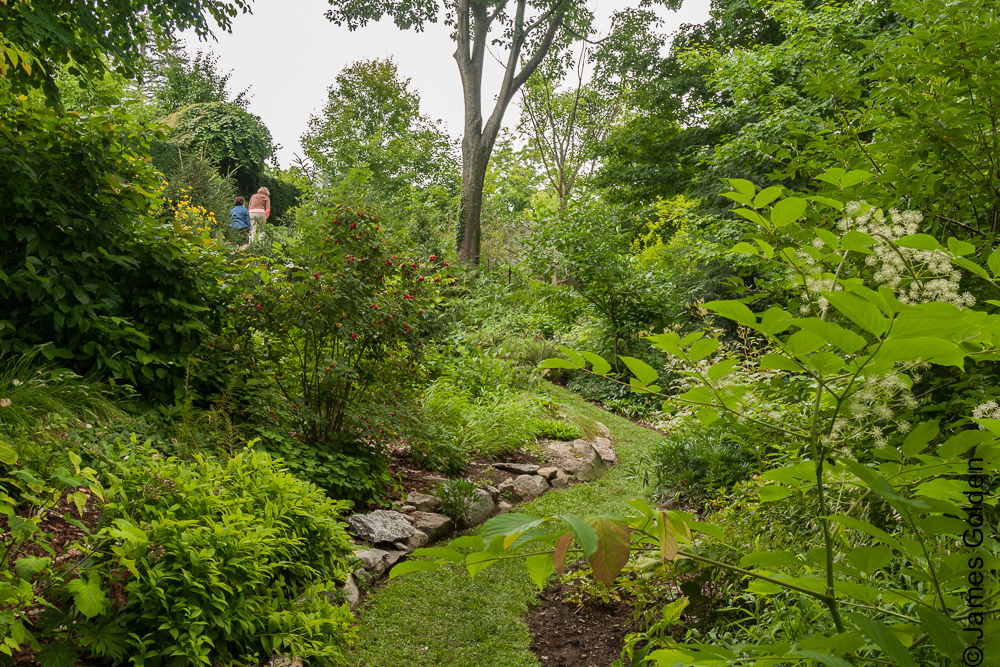
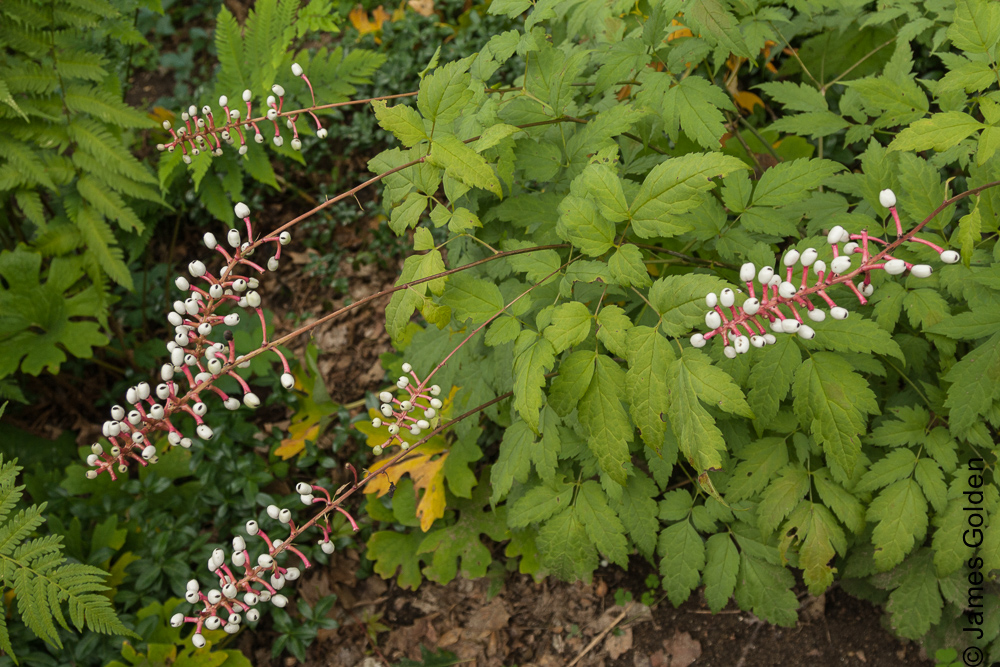
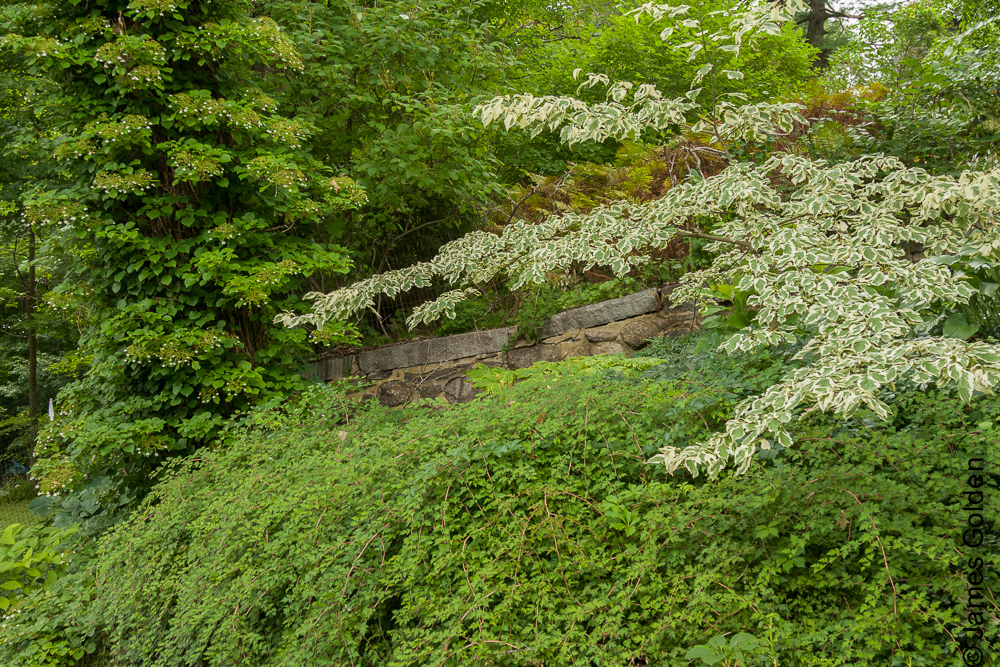 Though I've known Michael for several years, and looked at photos of his garden many times, the emotional effect of his hillside site was a total surprise, as were many of the details in the garden. And lest I be misunderstood, I don't "read" the garden as a reference to the myth of Persephone (though it may be), but as a broader, deeper, more archetypal human response to movement downward then back up through a beautiful garden.As a final note, I mention the beauty of Michael's fine cultivar of Bergenia, which more than one gardener envies! It is exemplary of the care and deliberation with which he selects his plants, and designs his garden.
Though I've known Michael for several years, and looked at photos of his garden many times, the emotional effect of his hillside site was a total surprise, as were many of the details in the garden. And lest I be misunderstood, I don't "read" the garden as a reference to the myth of Persephone (though it may be), but as a broader, deeper, more archetypal human response to movement downward then back up through a beautiful garden.As a final note, I mention the beauty of Michael's fine cultivar of Bergenia, which more than one gardener envies! It is exemplary of the care and deliberation with which he selects his plants, and designs his garden.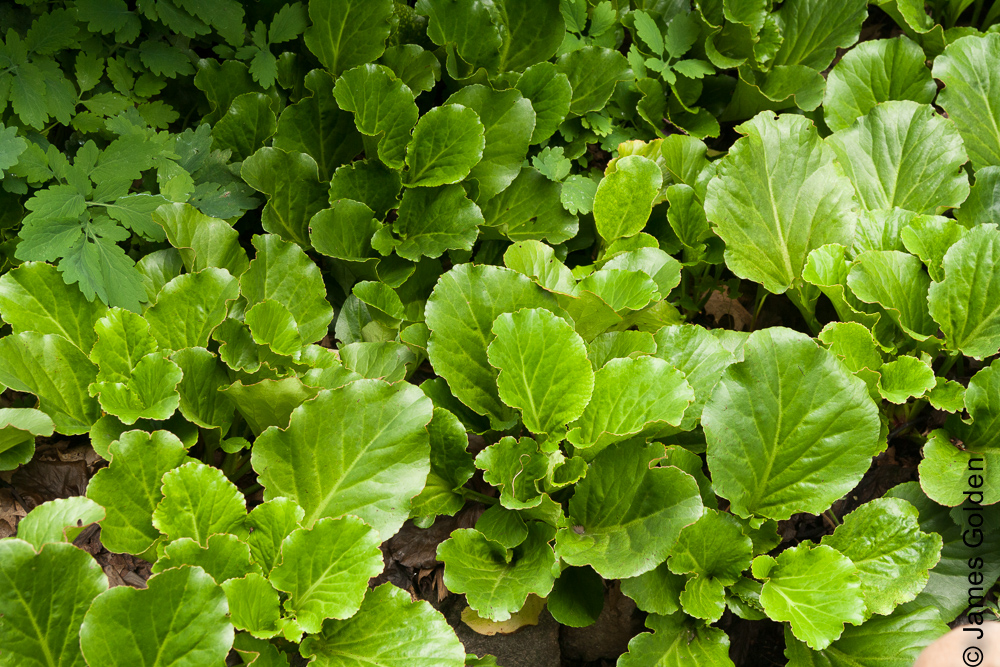 Michael blogs at The Gardener's Eye.
Michael blogs at The Gardener's Eye.